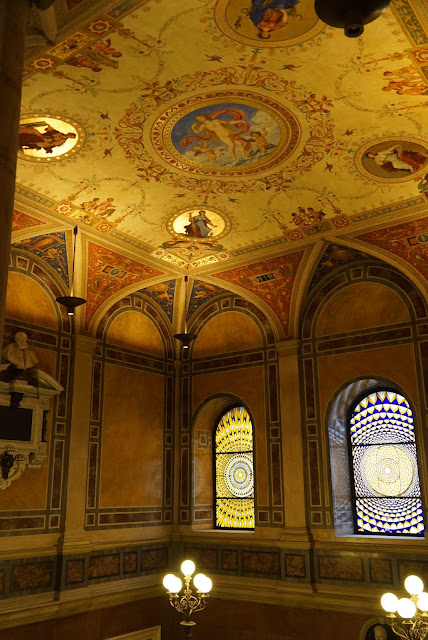They really love their marble:
The collection is somewhat limited in its range, compared to some other encyclopedic museums; there is little in the way of Italian pre-renaissance art, for example. And there are virtually no works by Austrian painters; it's mostly what the Hapsburgs collected. Though I can't think of any Austrian painters before 1870. One of the highlights is a room full of Breugels; they are truly wonderful seen in person. Other highlights include some late Velasquez works, and Vermeer's "The Art of Painting". And much, much more.
I had expected the museum to be quite crowded, especially during the height of the tourist season. But it was very quiet, and even empty in some spots. And there are those wonderful couches, a balm to exhausted museum goers.
Vienna's most famous native painter is Gustav Klimt, and Vienna makes sure that you know it. He is everywhere. There is even this:
We visited the Belvedere Museum, which has a wonderful collection of Klimts, including the world famous "The Kiss", which has almost achieved the iconic status of the Mona Lisa and the like. It's behind bulletproof glass, and there is even a separate room where they have a full size reproduction that can be used for taking selfies.
Beyond all the hype, though, the Klimts are wonderful to look at, and it is nice to be able to see the details which get lost in book size reproductions:
The Belvedere Museum is in yet another spectacular Hapsburg palace. It has some elaborate trompe l'oeil ceilings, which when photographed become even more confusing.
The applied arts museum (MAK) has the original sketches for Klimt's Beethoven Frieze. Some details:
The museum of applied arts is yet another lavishly decorated Vienna museum building.
And amazing stained glass windows:
In both the Belvedere Museum and the Leopold Museum there are many paintings by Vienna's other iconic painter, Egon Schiele. Mostly what we see of Schiele's work in North America is his graphic and expressionistic nudes and self-portraits (at the Neue Galerie in New York). While Schiele's work certainly still evokes a tormented soul, in Vienna there is a great deal more of his landscapes and other works, which to my mind, show Schiele as a painter with a much greater range of expression than I had previously thought.
Detail from above:
I also visited a smaller museum, attached to a church (I have forgotten the name) which had a collection of medieval paintings. No photos were allowed in the museum, but when I opened a closed door which said something like "Natural Specimens" on it, this is what I saw:
There are many, many other museums that we did not see. Vienna has an extraordinary number of museums of all kinds that I suspect would be fascinating to see. Next time!
























No comments:
Post a Comment